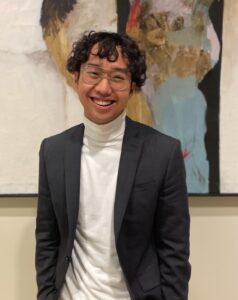Spring 2022 Graduate Student Research Highlights
Spring Newsletter 2022 graduate student research highlights:
Ella H oogenboezem, 5th year graduate student in the Duvall lab
oogenboezem, 5th year graduate student in the Duvall lab
Short interfering RNA (siRNA) is a powerful gene silencing platform that has the potential to silence tumor-driving genes. However, siRNA medicines for tumor delivery have remained clinically elusive. In their native form, siRNAs are rapidly cleared by the body and lack the ability to target cells of interest. My research revolves around the development of in situ forming albumin-siRNA nanocomplexes to overcome these obstacles. Albumin, the most abundant protein in our blood, has an exceptionally long circulation half-life and naturally ferries fatty acids and other hydrophobic cargo throughout the circulation. Importantly, tumor cells preferentially take up albumin to meet their high energy needs, making it an excellent native, tumor-targeting ferry. By modifying siRNA with a fatty acid like moiety, we can hitchhike on the body’s endogenous albumin to extend circulation and increase tumor accumulation of our siRNAs. Through systematic structural interrogation of our siRNA nanocomplex precursor, we have achieved optimized albumin-binding, circulation half-life, tumor accumulation, and ultimate target gene silencing in the tumor. Currently, I am investigating using this platform to target anti-apoptotic proteins in cancer cells. These anti-apoptotic proteins allow cancer cells to survive when they should normally die in response to stressors such as chemotherapy. This platform has the potential to allow chemoresistant cancers to be susceptible to treatment once more.
 Jeremy Espano, 3rd year graduate student in the Macdonald lab
Jeremy Espano, 3rd year graduate student in the Macdonald lab
Nature is truly the expert at making a wide variety of materials. In fact, nature can make materials that have the same elemental composition but differ in their atomic crystal structures or phase. Materials, such as metal chalcogenides, can exist as many different phases, and each phase can exhibit different magnetic and electronic properties leading to unique uses in various applications including batteries and catalysis. The ability to selectively synthesize phase pure materials will widen the breadth of applications immensely as well as help us understand the mechanisms behind geological phenomenon.
Past attempts at controlling and understanding phase have often been described as serendipitous. By further understanding the role that organochalcogenide chemistry plays in the synthesis of metal chalcogenide materials, we can slowly begin to control phase.
Through the use of a wide range of thioureas, we can learn about the decomposition speed of these organochalcogenide precursors and understand how the kinetics of how nanoparticle synthesis can affect the resulting phase. Using this chemistry, I synthesize a wide variety of nanoparticles using various solvents, temperatures, and precursors metals. I then analyze these nanoparticles using X-ray diffraction and transmission electron microscopy to see the role that kinetics plays on nanoparticle phase. Understanding these mechanisms brings us one step closer to obtaining a complete phase map and catalogue of metal thioureas that was previously unavailable.
